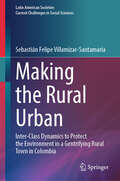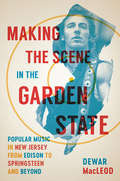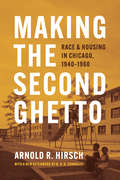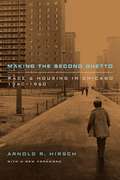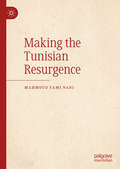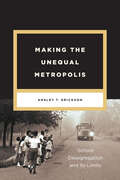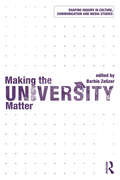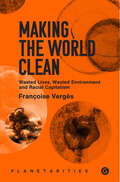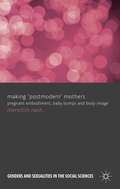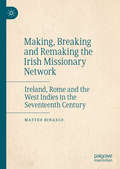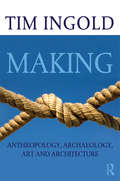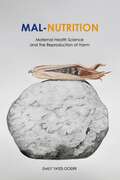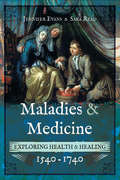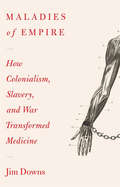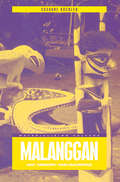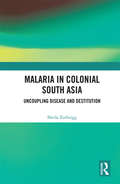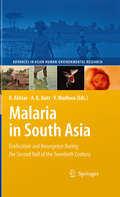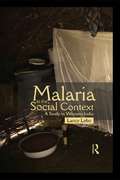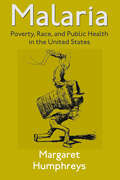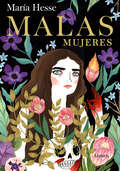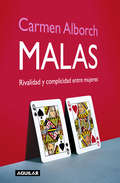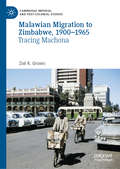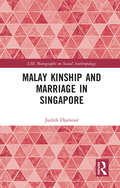- Table View
- List View
Making the Right Choice: Narratives of Marriage in Sri Lanka (Politics of Marriage and Gender: Global Issues in Local Contexts)
by Asha L. AbeyasekeraMaking the Right Choice unravels the entangled relationship between marriage, morality, and the desire for modernity as it plays out in the context of middle-class status concerns and aspirations for upward social mobility within the Sinhala-Buddhist community in urban Sri Lanka. By focusing on individual life-histories spanning three generations, the book illuminates how narratives about a gendered self and narratives about modernity are mutually constituted and intrinsically tied to notions of agency. The book uncovers how "becoming modern" in urban Sri Lanka, rather than causing inter-generational conflict, is a collective aspiration realized through the efforts of bringing up educated and independent women capable of making "right" choices. The consequence of this collective investment is a feminist conundrum: agency does not denote the right to choose, but the duty to make the "right" choice; hence agency is experienced not as a sense of "freedom," but rather as a burden of responsibility.
Making the Rural Urban: Inter-Class Dynamics to Protect the Environment in a Gentrifying Rural Town in Colombia (Latin American Societies)
by Sebastián Felipe Villamizar-SantamaríaThis book takes the small rural town of La Calera, in the outskirts of the Colombian capital of Bogotá, as a case study to analyze how residents from different social classes – wealthier ex-urban newcomers arriving to traditionally peasant and rural areas – interact to decide how nature will be used in the face of further urban expansion. Contrary to the conflicts in other gentrification cases, including those of “green” gentrification, this book shows how newcomers and longtimers in La Calera use environmental concerns to bridge social class rifts and push the state to provide water, public space, and decision-making power. Residents see abundant ecological resources like water and land around them, but they do not have access to aqueducts, green public space or power over planning decisions affecting the distribution of these resources. As a response, and to challenge the state more effectively, newcomers and longtimers create inter-class alliances through what the author calls third nature: the way residents try to both protect and keep using existing ecological goods. To do so, despite high levels of class inequality, residents had a similar goal of protecting ecological resources around them by intervening in the physical and political landscapes against a state that induces scarcity, selectively enforcing environmental policies to the detriment of Calerunos. As cities all around the Global South continue to grow, urban expansion posits a threat to the environment by transforming agricultural and protected areas into denser residential or touristic spaces. Moreover, as natural resources become scarcer in the face of climate change, inequality might further existing environmental privileges and vulnerabilities. By examining closely how Calerunos bridge class inequalities for environmental reasons, this case highlights processes that inform other gentrifying rural spaces around the world.
Making the Scene
by Stuart HendersonMaking the Scene is a history of 1960s Yorkville, Toronto's countercultural mecca. It narrates the hip Village's development from its early coffee house days, when folksingers such as Neil Young and Joni Mitchell flocked to the scene, to its tumultuous, drug-fuelled final months. A flashpoint for hip youth, politicians, parents, and journalists alike, Yorkville was also a battleground over identity, territory, and power. Stuart Henderson explores how this neighbourhood came to be regarded as an alternative space both as a geographic area and as a symbol of hip Toronto in the cultural imagination.Through recently unearthed documents and underground press coverage, Henderson pays special attention to voices that typically aren't heard in the story of Yorkville - including those of women, working class youth, business owners, and municipal authorities. Through a local history, Making the Scene offers new, exciting ways to think about the phenomenon of counterculture and urban manifestations of a hip identity as they have emerged in cities across North America and beyond.
Making the Scene in the Garden State: Popular Music in New Jersey from Edison to Springsteen and Beyond
by Dewar MacLeodMaking the Scene in the Garden State explores New Jersey’s rich musical heritage through stories about the musicians, listeners and fans who came together to create sounds from across the American popular music spectrum. The book includes chapters on the beginnings of musical recording in Thomas Edison’s factories in West Orange; early recording and the invention of the Victrola at Victor Records’ Camden complex; Rudy Van Gelder’s recording studios (for Blue Note, Prestige, and other jazz labels) in Hackensack and Englewood Cliffs; Zacherley and the afterschool dance television show Disc-o-Teen, broadcast from Newark in the 1960s; Bruce Springsteen’s early years on the Jersey Shore at the Upstage Club in Asbury Park; and, the 1980s indie rock scene centered at Maxwell’s in Hoboken. Concluding with a foray into the thriving local music scenes of today, the book examines the sounds, sights and textures of the locales where New Jerseyans have gathered to rock, bop, and boogie.
Making the Second Ghetto: Race & Housing in Chicago, 1940–1960 (Historical Studies of Urban America)
by Arnold R. HirschFirst published in 1983 and praised by the likes of Ta-Nehisi Coates and Thomas Sugrue, Arnold R. Hirsch’s Making the Second Ghetto is the rare book that has only become more piercingly prescient over the years. Hirsch’s classic and groundbreaking work of urban history is a revelatory look at Chicago in the decades after the Great Depression, a period when the city dealt with its rapidly growing Black population not by working to abolish its stark segregation but by expanding and solidifying it. Even as the civil rights movement rose to prominence, Chicago exploited a variety of methods of segregation—including riots, redevelopment, and a host of new legal frameworks—that provided a national playbook for the emergence of a new kind of entrenched inequality. Hirsch’s chronicle of the strategies employed by ethnic, political, and business interests in reaction to the Great Migration of Southern Blacks in the mid-twentieth century makes startingly clear how the violent reactions of an emergent white population found common ground with policy makers to segregate first a city and then the nation. This enlarged edition of Making the Second Ghetto features a visionary afterword by historian N. D. B. Connolly, explaining why Hirsch’s book still crackles with “blistering relevance” for contemporary readers.
Making the Second Ghetto: Race and Housing in Chicago, 1940-1960
by Arnold R. HirschIn Making the Second Ghetto, Arnold Hirsch argues that in the post-depression years Chicago was a "pioneer in developing concepts and devices" for housing segregation. Hirsch shows that the legal framework for the national urban renewal effort was forged in the heat generated by the racial struggles waged on Chicago's South Side. His chronicle of the strategies used by ethnic, political, and business interests in reaction to the great migration of southern blacks in the 1940s describes how the violent reaction of an emergent "white" population combined with public policy to segregate the city. "In this excellent, intricate, and meticulously researched study, Hirsch exposes the social engineering of the post-war ghetto. "—Roma Barnes, Journal of American Studies "According to Arnold Hirsch, Chicago's postwar housing projects were a colossal exercise in moral deception. . . . [An] excellent study of public policy gone astray. "—Ron Grossman, Chicago Tribune "An informative and provocative account of critical aspects of the process in [Chicago]. . . . A good and useful book. "—Zane Miller, Reviews in American History "A valuable and important book. "—Allan Spear, Journal of American History
Making the Tunisian Resurgence
by Mahmoud Sami NabiThis book investigates the socioeconomic factors that triggered Tunisia’s "revolution for dignity” and the current issues and challenges facing its economy while suggesting mechanisms and instruments for their resolution. The author begins by analyzing the roots of the revolution and the post-revolution situation from a political sociology perspective and then diagnoses the Tunisian economy before and after the revolution and identifies the multidimensional binding constraints preventing it from escaping the middle-income trap. The book then explores the pillars of an inclusive development strategy that Tunisia should pursue. The emphasis is made on building inclusive institutions, developing a new social contract and reinventing the country's leadership. Beyond the institutional dimension, the author suggests innovative financial channels, discusses the strategy of a successful integration of the Tunisian economy in the global economy as well as the pillars of its transformation into a knowledge-based economy.
Making the Unequal Metropolis: School Desegregation and Its Limits (Historical Studies of Urban America)
by Ansley T. EricksonIn a radically unequal United States, schools are often key sites in which injustice grows. Ansley T. Erickson's Making the Unequal Metropolis presents a broad, detailed, and damning argument about the inextricable interrelatedness of school policies and the persistence of metropolitan-scale inequality. While many accounts of education in urban and metropolitan contexts describe schools as the victims of forces beyond their control, Erickson shows the many ways that schools have been intertwined with these forces and have in fact--via land-use decisions, curricula, and other tools--helped sustain inequality. Taking Nashville as her focus, Erickson uncovers the hidden policy choices that have until now been missing from popular and legal narratives of inequality. In her account, inequality emerges not only from individual racism and white communities' resistance to desegregation, but as the result of long-standing linkages between schooling, property markets, labor markets, and the pursuit of economic growth. By making visible the full scope of the forces invested in and reinforcing inequality, Erickson reveals the complex history of, and broad culpability for, ongoing struggles in our schools.
Making the University Matter (Shaping Inquiry in Culture, Communication and Media Studies)
by Barbie ZelizerMaking the University Matter investigates how academics situate themselves simultaneously in the university and the world and how doing so affects the viability of the university setting. The university stands at the intersection of two sets of interests, needing to be at one with the world while aspiring to stand apart from it. In an era that promises intensified political instability, growing administrative pressures, dwindling economic returns and questions about economic viability, lower enrolments and shrinking programs, can the university continue to matter into the future? And if so, in which way? What will help it survive as an honest broker? What are the mechanisms for ensuring its independent voice? Barbie Zelizer brings together some of the leading names in the field of media and communication studies from around the globe to consider a multiplicity of answers from across the curriculum on making the university matter, including critical scholarship, interdisciplinarity, curricular blends of the humanities and social sciences, practical training and policy work. The collection is introduced with an essay by the editor and each section has a brief introduction to contextualise the essays and highlight the issues they raise.
Making the World Clean: Wasted Lives, Wasted Environment, and Racial Capitalism (Goldsmiths Press / Planetarities)
by Francoise VergesAn antiracist theory of cleaning.In Making the World Clean: Wasted Lives, Wasted Environment, and Racial Capitalism, Françoise Vergès examines the racial and gendered politics of wasting lands, bodies, and resources and the organized deprivation of clean water, shelter, and access to health services—in other words, the structural denial, along racial lines, of vital needs. Through 38 short sections, she looks at the social relations that have made cleaning into drudgery and into a racialized, gendered, poorly paid job that is nevertheless necessary for any society to function. She concludes with the proposition of a feminist, decolonial, antiracist, anti-patriarchal, and anti-capitalist politics of cleaning. Or, simply put, of &“decolonial cleaning.&”To Vergès, the structural denial of the elemental needs of women of color (sanitary pads, access to water, and privacy for basic washing), and why these needs are considered insignificant and trivial, shows how racism and class war are gendered. By examining the banal, the trivial, and the elemental, the author addresses cleaning as a necessity rather than the maintenance of a consumerist lifestyle, a condition of basic care of the body and the mind that is considered with indifference by racial capitalism, white environmentalism, and even, too often, by humanitarian organizations. She argues that by building &“life-affirming institutions,&” as Ruth Wilson Gilmore advocates, struggles against the whitening of cleaning create sites of freedom. &“Decolonial cleaning&” imagines cleaning as taking care of land, humans, plants, animals, and rivers, not seeking to discipline them or transform them into commodities or objects of conservation but cleaning as a practice dedicated to sustaining the living world.
Making ‘Postmodern’ Mothers
by Meredith NashBased on interviews with pregnant women, this book provides a multi-disciplinary empirical account of pregnant embodiment and how it relates to wider sociological and feminist discourses about gender, bodies, 'fitness', 'fat', celebrity and motherhood.
Making, Breaking and Remaking the Irish Missionary Network: Ireland, Rome and the West Indies in the Seventeenth Century
by Matteo BinascoThis book reconstructs the efforts that were made to establish a missionary network between the two Irish Colleges of Rome, Ireland, and the West Indies during the seventeenth century. It analyses the process which brought the Irish clergy to establish two dedicated colleges in the epicenter of early modern Catholicism and to develop a series of missionary initiatives in the English islands of the West Indies. During a period of great political change in Ireland, continental Europe and the Atlantic region, the book traces how and through which key figures and institutions this clerical channel was established, while at the same time identifying the main obstacles to its development.
Making: Anthropology, Archaeology, Art and Architecture
by Tim IngoldMaking creates knowledge, builds environments and transforms lives. Anthropology, archaeology, art and architecture are all ways of making, and all are dedicated to exploring the conditions and potentials of human life. In this exciting book, Tim Ingold ties the four disciplines together in a way that has never been attempted before. In a radical departure from conventional studies that treat art and architecture as compendia of objects for analysis, Ingold proposes an anthropology and archaeology not of but with art and architecture. He advocates a way of thinking through making in which sentient practitioners and active materials continually answer to, or ‘correspond’, with one another in the generation of form. Making offers a series of profound reflections on what it means to create things, on materials and form, the meaning of design, landscape perception, animate life, personal knowledge and the work of the hand. It draws on examples and experiments ranging from prehistoric stone tool-making to the building of medieval cathedrals, from round mounds to monuments, from flying kites to winding string, from drawing to writing. The book will appeal to students and practitioners alike, with interests in social and cultural anthropology, archaeology, architecture, art and design, visual studies and material culture.
Mal-Nutrition: Maternal Health Science and the Reproduction of Harm
by Emily Yates-DoerrA free ebook version of this title is available through Luminos, University of California Press’s Open Access publishing program. Visit www.luminosoa.org to learn more.Mal-Nutrition documents how maternal health interventions in Guatemala are complicit in reproducing poverty. Policy makers speak about how a critical window of biological growth around the time of pregnancy—called the "first 1,000 days of life"—determines health and wealth across the life course. They argue that fetal development is the key to global development. In this thought-provoking and timely book, Emily Yates-Doerr shows that the control of mothering is a paradigmatic technique of American violence that serves to control the reproduction of privilege and power. She illustrates the efforts of Guatemalan scientists, midwives, and mothers to counter the harms of such mal-nutrition. Their powerful stories offer a window into a form of nutrition science and policy that encourages collective nourishment and fosters reproductive cycles in which women, children, and their entire communities can flourish.
Maladies & Medicine: Exploring Health & Healing, 1540–1740
by Jennifer Evans Sara ReadA lively account of medical practices in early modern England: &“Superb . . . an essential piece of social history.&” —Books Monthly It was an era when tooth cavities were thought to be caused by tiny worms and smallpox by an inflammation of the blood, and cures ranged from herbal potions, cooling cordials, blistering the skin, and of course letting blood. Maladies and Medicine tells the story of how the body was understood before the major advances of modern medicine, covering the theory of the four humors and the ways that male and female bodies were conceptualized. It also explains the hierarchy of healers, from university-trained physicians to the women who traveled the country offering cures based on inherited knowledge of homemade remedies, as well as the print explosion of medical health guides, which began to appear in the sixteenth century, from more academic medical textbooks to cheap almanacs. In twenty chapters discussing attitudes toward, and explanations of, some of the most common diseases and medical conditions of the period, the book reveals the ways people understood them and the steps they took to get better. It examines the body from head to toe, from migraines to gout. Case studies and personal anecdotes taken from doctors&’ notes, personal journals, diaries, letters, and even court records show the reactions of individuals to their illnesses and treatments, bringing us into close proximity with people who lived roughly four centuries ago. This richly illustrated study will fascinate those curious about the history of the body and the way our ancestors lived.
Maladies of Empire: How Colonialism, Slavery, and War Transformed Medicine
by Jim DownsA sweeping global history that looks beyond European urban centers to show how slavery, colonialism, and war propelled the development of modern medicine. Most stories of medical progress come with ready-made heroes. John Snow traced the origins of London’s 1854 cholera outbreak to a water pump, leading to the birth of epidemiology. Florence Nightingale’s contributions to the care of soldiers in the Crimean War revolutionized medical hygiene, transforming hospitals from crucibles of infection to sanctuaries of recuperation. Yet histories of individual innovators ignore many key sources of medical knowledge, especially when it comes to the science of infectious disease. Reexamining the foundations of modern medicine, Jim Downs shows that the study of infectious disease depended crucially on the unrecognized contributions of nonconsenting subjects—conscripted soldiers, enslaved people, and subjects of empire. Plantations, slave ships, and battlefields were the laboratories in which physicians came to understand the spread of disease. Military doctors learned about the importance of air quality by monitoring Africans confined to the bottom of slave ships. Statisticians charted cholera outbreaks by surveilling Muslims in British-dominated territories returning from their annual pilgrimage. The field hospitals of the Crimean War and the US Civil War were carefully observed experiments in disease transmission. The scientific knowledge derived from discarding and exploiting human life is now the basis of our ability to protect humanity from epidemics. Boldly argued and eye-opening, Maladies of Empire gives a full account of the true price of medical progress.
Malanggan: Art, Memory and Sacrifice (Materializing Culture)
by Susanne KüchlerShortlisted for the Katharine Briggs Folkore Award 2003 Malanggan are among the most treasured possessions in the Pacific, yet they continue to confound anthropologists. Central to funerals in New Ireland, these ‘death' figures are intended to decompose as symbolic representations of the dead. Wrapped in images that are conceived of as ‘skins', they are both visually complex and intriguing. This book is the first to interpret these mysterious agents of resemblance and connection as having a cognitive rather than a linguistic basis. Found in nearly every ethnographic museum in the world, Malanggan collections have been left virtually untouched. This original study begins by tracing the history of the collections and moves on to consider the role these artefacts play in sacrifice, ritual and exchange. What is the relationship between Malanggan and memory? How can Malanggan be understood as a life force as well as a vehicle for thought? In an analysis of the cognitive aspects of Malanggan, Küchler offers a highly original conceptualization of the centrality of the knot as a mode of being, thinking and binding in the Pacific. Malanggan: Art, Memory and Sacrifice is a groundbreaking study. Based on fifteen years of fieldwork and collection research, it provides an incisive new take on one of the Pacific's classic puzzles, as well as a wealth of new information and resources for anthropologists, collectors and curators alike.
Malaria in Colonial South Asia: Uncoupling Disease and Destitution
by Sheila ZurbriggThis book highlights the role of acute hunger in malaria lethality in colonial South Asia and investigates how this understanding came to be lost in modern medical, epidemic, and historiographic thought. Using the case studies of colonial Punjab, Sri Lanka, and Bengal, it traces the loss of fundamental concepts and language of hunger in the inter-war period with the reductive application of the new specialisms of nutritional science and immunology, and a parallel loss of the distinction between infection (transmission) and morbid disease. The study locates the final demise of the ‘Human Factor’ (hunger) in malaria history within pre- and early post-WW2 international health institutions – the International Health Division of the Rockefeller Foundation and the nascent WHO’s Expert Committee on Malaria. It examines the implications of this epistemic shift for interpreting South Asian health history, and reclaims a broader understanding of common endemic infection (endemiology) as a prime driver, in the context of subsistence precarity, of epidemic mortality history and demographic change. This book will be useful to scholars and researchers of public health, social medicine and social epidemiology, imperial history, epidemic and demographic history, history of medicine, medical sociology, and sociology.
Malaria in South Asia
by Rais Akhtar Ashok K. Dutt Vandana WadhwaThis highly topical book provides an in-depth account of the South Asian experience with the deadly disease that has held this region hostage for millennia. The book touches specifically on the resurgence of malaria experienced in the second half of the twentieth century, which occurred just a few years after malaria was thought to have been virtually eradicated from the region. The progress of this reappearance across space and time, as well as its causes and consequences, are discussed. The book also covers past, present and future ways to curb, control and ultimately, conquer malaria. As malaria continues to ravage the developing world, even in today's 'age of science', this is a particularly relevant book, especially as most studies analyze the problem in Africa, the continent that bears the brunt of this disease. Here, the authors call attention to challenges in South Asia, home to an immense at-risk population. The chapters in this book use a range of conceptual frameworks, quantitative analyses and descriptive aapproaches, finding that malaria is not just a complex disease driven by highly adaptive agents and vectors thriving in particular ecologies, but also a social concern deeply related to the region's cultural traditions, financial and developmental shortfalls, and inexorably related to political will. The book comprehensively deals with all aspects of the malaria situation in South Asia, and is invaluable to upper level students as well as emerging and established scholars in the fields of medical geography and epidemiology, Asian studies and development studies.
Malaria in the Social Context: A Study in Western India
by Lancy LoboThis book underscores how, apart from bacteriological factors, human behavioural characteristics as well as the socio-cultural factors that affect people’s lives contribute to the risk for and prevention of infection, with particular focus on malaria. It argues that the implementation of malaria-control measures can be successful only if it considers the human response to malaria and control measures. Any new tool which is introduced in a particular area — be it a new vaccine, a new drug combination, the promotion of impregnated bed nets, spraying of insecticides, or improved home management — will be effective and sustainable only if it is adapted to needs of the local population, i.e., if it makes sense to them. This volume also studies traditional knowledge systems with respect to health and malaria, arguing that local knowledge about infection is the result of an amalgamation of the biomedical and the traditional. By attempting to identify how traditional and biomedical elements interrelate in local illness concepts, it hopes to assist health interventionists in providing efficacious health education and awareness among people.
Malaria: Poverty, Race, and Public Health in the United States
by Margaret HumphreysFrom a prominent medical historian, “a fascinating story of the spread of malaria through the USA following its introduction in the seventeenth century” (Nature Medicine).Margaret Humphreys presents the first book-length account of the parasitic, insect-borne disease that has infected millions and influenced settlement patterns, economic development, and the quality of life at every level of American society, especially in the south and during its peak in the nineteenth century.Humphreys approaches malaria from three perspectives: the parasite’s biological history, the medical response to it, and the patient’s experience of the disease. It addresses numerous questions including how the parasite thrives and eventually becomes vulnerable, how professionals came to know about the parasite and learned how to fight it, and how people view the disease and came to the point where they could understand and support the struggle against it.In addition Malaria: Poverty, Race, and Public Health in the United States argues that malaria control was central to the evolution of local and federal intervention in public health, and demonstrates the complex interaction between poverty, race, and geography in determining the fate of malaria.“A masterpiece . . . recommended reading for anyone involved in or interested in health care.”?Southern Medical Journal“The lack of jargon makes the book accessible to a wide audience.”?Journal of the History of Medicine
Malas mujeres
by María HesseUna historia de las mujeres que han encarnado el mal, llena de humor e inteligencia, por la autora de Frida Kahlo y El placer, con más de 200.000 lectores. TODAS #MALASMUJERES UNO DE LOS DIEZ LIBROS MÁS ESPERADOS DE 2022 SEGÚN ESQUIRE NI LOCAS, NI TONTAS, NI PROVOCADORAS, NI FATALES: ¡MUJERES, BIENVENIDAS AL AQUELARRE! Desde la aparición de los primeros mitos, lo universal ha sido la narración de los hombres, esa visión masculina que dibujó a unos y a otras, nos dijo cómo debíamos ser -puras, dóciles, amorosas- y previno al mundo de las malas mujeres, ya fueran vengativas gorgonas, crueles madrastras, problemáticas Pandoras o Evas incautas que cargaron con la culpa de nuestro destino. En su personalísima versión, María Hesse da una vuelta de tuerca a esas princesas pasivas, brujas perversas, malas madres, femmes fatales, locas pasionales y secundarias perfectas, y, de Madame Bovary a Sarah Connor, de Juana «la Loca» a Yoko Ono, de Helena de Troya a Monica Lewinsky, de Medusa a Zahara o a Nevenka, reivindica la necesidad de encontrar otros referentes, nuevas lecturas de la Historia e inspiración para ser simplemente mujeres en el mundo en que vivimos. «Ahora sabemos que no hay que tener miedo a salirse de esas líneas caprichosas que otros marcaron, y que las que abrieron esas grietas buscando otros horizontes no estaban locas, ni eran perversas ni malos ejemplos para otras. Si acaso fueron mujeres valientes, fuertes, atrevidas, decididas. Rompedoras. Y si las llaman malas mujeres que se lo llamen; las paredes han caído y nosotras ya no estaremos ahí para oírlo».María Hesse La crítica ha dicho:«Con unas ilustraciones bellísimas y repletas de personalidad, su nuevo libro recupera la vida de las "malas mujeres" en una burla irónica e inteligente [...] porque igual no fueron malas mujeres, sino mujeres valientes, fuertes y rompedoras que merecen que Maria Hesse cuente (y dibuje) su historia.»Alberto Hernando, Esquire «María Hesse es uno de esos nuevos diamantes en bruto de la ilustración.»Harper's Bazaar «El dibujo no como horizonte escapista y mero entretenimiento, sino como reflejo de realidades y fuente de revelaciones.»Javier Ors, El Confidencial «Un estilo inconfundible que busca fusionar lo sintético con lo orgánico.»Javier Rubio Nomblot, ABC Cultural «[El trazo de Hesse]: personal, bello y delicado, es inconfundible.»Isabel Loscertales, Woman «Una obra vanguardista, íntima y conmovedora.»Lidia González, Traveler «Hesse tiene la enorme virtud de hacer que ídolos inalcanzables nos puedan parecer tremendamente cercanos.»Juan Rodríguez Millán, Cómic para todos «A través de su trazo suave y visceral habla de las luces y sombras de muchos referentes, de libertad, de amor, de amigas, de fuegos, de poesía, de imposiciones canónicas de belleza y de coños.»Marina López, Soria Noticias «La obra de María Hesse ha sido expuesta en diversas exposiciones y cuenta con un trabajo personal donde la sensibilidad y la mujer son las grandes protagonistas.»Seviocio
Malas: Rivalidad y complicidad entre mujeres
by Alborch, CarmenDe nuevo, como en su libro anterior, Carmen Alborch acierta al plantear, desde la franqueza intelectual, cuestiones que de verdad interesan a las mujeres. «Nos queremos, nos envidiamos, nos compadecemos, nos enfadamos, nos prestamos a la confidencia, nos apoyamos, competimos, nos divertimos y aprendemos juntas», escribe Carmen Alborch en la introducción a esta obra. La autora de Solas nos habla en las páginas de este libro de algunas cuestiones clave en las relaciones entre mujeres en el comienzo del siglo XXI: De la rivalidad que las ha enfrentado históricamente y aún las enfrenta por los mismos o nuevos motivos; de la presunción de #maldad# extendida a casi todas ellas por las tradiciones culturales hegemónicas en cada época histórica, de mujeres relevantes en numerosos y diferentes campos de la actividad humana, célebres o anónimas. Y también se refiere a la complicidad entre mujeres, esa hermosa connivencia tejida en mil alianzas y relaciones de muy variada naturaleza #algunas seculares, milenarias incluso-, otras más actuales con clara dimensión política, donde las mujeres se encuentran para que sus voces sean oídas y respetadas.
Malawian Migration to Zimbabwe, 1900–1965: Tracing Machona (Cambridge Imperial and Post-Colonial Studies)
by Zoë R. GrovesThis book explores the culture of migration that emerged in Malawi in the early twentieth century as the British colony became central to labour migration in southern Africa. Migrants who travelled to Zimbabwe stayed for years or decades, and those who never returned became known as machona – ‘the lost ones’. Through an analysis of colonial archives and oral histories, this book captures a range of migrant experiences during a period of enormous political change, including the rise of nationalist politics, and the creation and demise of the Central African Federation. Following migrants from origin to destination, and in some cases back again, this book explores gender, generation, ethnicity and class, and highlights life beyond the workplace in a racially segregated city. Malawian men and women shaped the culture and politics of urban Zimbabwe in ways that remain visible today. Ultimately, the voluntary movement of Africans within the African continent raises important questions about the history of diaspora communities and the politics of belonging in post-colonial Africa.
Malay Kinship and Marriage in Singapore (LSE Monographs on Social Anthropology #Vol. 21)
by Judith DjamourDr Djamour spent two years in Singapore, both in the city and in a Malay fishing village, and her first-hand account draws a lively and sympathetic picture of behaviour within the family and between kinsmen. It is nonetheless an important contribution to social anthropology and discusses, as its central topic, the instability of Malay marriage. The causes and consequences of this phenomenon, which involve social, economic, and psychological considerations, are analysed in some detail. The social picture which emerges has wide validity throughout the country and should prove of value to all who seek a fuller knowledge of Malay society.

